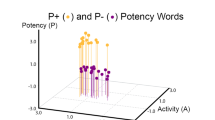Abstract
Studies addressed the hypothesis that people perceive lower status individuals as more feminine- than masculine-typed, and higher status individuals as more masculine- than feminine-typed, even when the feminine and masculine descriptors are equated in terms of their potency, evaluation, or activity; the latter are underlying dimensions of meaning (Osgood, Suci, & Tannenbaum, 1957), and potency and activity are linked to status. Participants were presented the minimal status instantiation of Conway, Pizzamiglio, and Mount (1996) and rated low- and high-status individuals in terms of Adjective Check List (Gough & Heilbrun, 1980) descriptors. The expected status × gender-typing interactions emerged in Study 1 for the negative low-potency indices for male and female participants, and for the positive low-potency indices for female participants alone. Similarly, the status × gender-typing interactions emerged in Study 2 for the low-potency indices, for both low and high activity. Contrary to expectation, high-potency terms were generally attributed to high-status individuals. The findings indicated that status seems to be gendered beyond the correspondence observed in prior research between status and gender for the dimensions of potency and activity.
Similar content being viewed by others
References
Ashmore, R. D. (1981). Sex stereotypes and implicit personality theory. In D. L. Hamilton (Ed.), Cognitive processes in stereotyping and intergroup behavior (pp. 37–81). Hillsdale, NJ: Erlbaum.
Berger, J., Wagner, D. G.,& Zelditch, M. (1985). [Introduction] Expectation states theory: Review and assessment. In J. Berger& M. Zelditch (Eds.), Status, rewards, and influence: How expectations organize behavior (pp. 1–72). San Francisco: Jossey-Bass.
Biernat, M.,& Kobrynowicz, D. (1997). Gender- and race-based standards of competence: Lower minimum standards but higher ability standards of devalued groups. Journal of Personality and Social Psychology, 72, 544–557.
Brewer, M. B.,& Lui, L. N. (1989). The primacy of age and sex in the structure of person categories. Social Cognition, 7, 262–274.
Brody, L. R.,& Hall, J. A. (1993). Gender and emotion. In M. Lewis& J. M. Haviland (Eds.), Handbook of emotions (pp. 447–460). New York: Guilford Press.
Bugental, D. B. (2000). Acquisition of the algorithms of social life: A domain-based approach. Psychological Bulletin, 126, 187–219.
Conway, M., Di Fazio, R.,& Mayman, S. (1999). Judging others' emotions as a function of the others' status. Social Psychology Quarterly, 62, 291–305.
Conway, M., Irannejad, S.,& Giannopoulos, C. (2005). Status-based expectancies for aggression, with regard to gender differences in aggression in social psychological research. Aggressive Behavior, 31, 381–398.
Conway, M., Pizzamiglio, M. T.,& Mount, L. (1996). Status, communality, and agency: Implications for stereotypes of gender and other groups. Journal of Personality and Social Psychology, 71, 25–38.
Conway, M.,& Vartanian, L. (2000). Status in gender stereotypes: Beyond communality and agency. Sex Roles, 43, 181–199.
Conway, M., Wood, W.-J., Dugas, M.,& Pushkar, D. (2003). Are women perceived as engaging in more maladaptive worry than men? A status interpretation. Sex Roles, 49, 1–10.
Craig, R. J.,& Bivens, A. (2000). Psychological needs associated with MMPI-2 scales in a nonclinical sample. Journal of Personality Assessment, 74, 439–446.
Deaux, K.,& LaFrance, M. (1998). Gender. In D. T. Gilbert, S. T. Fiske,& L. Gardner (Eds.), The handbook of social psychology (Vol. 1, 4th ed., pp. 788–827). New York: McGraw Hill.
Dépret, E.,& Fiske, S. T. (1993). Social cognition and power: Some cognitive consequences of social structure as a source of control deprivation. In G. Weary, F. Gleicher,& K. L. Marsh (Eds.), Control motivation and social cognition (pp. 176–202). New York: Springer-Verlag.
Deschamps, J. (1982). Social identity and relations of power between groups. In H. Tajfel (Ed.), Social identity and intergroup relations (pp. 85–98.). New York: Cambridge University Press.
Eagly, A. H., Johannesen-Schmidt, M. C.,& van Engen, M. L. (2003). Transformational, transactional, and laissez-faire leadership styles: A meta-analysis comparing women and men. Psychological Bulletin, 129, 569–591.
Fiske, A. P. (1992). The four elementary forms of sociality: Framework for a unified theory of social relations. Psychological Review, 99, 689–723.
Fiske, S. T.,& Taylor, S. E. (1991). Social cognition (2nd ed.). New York: McGraw-Hill.
Foschi, M. (1996). Double standards in the evaluation of men and women. Social Psychology Quarterly, 59, 237–254.
Glick, P.,& Fiske, S. T. (1999). Sexism and other ”isms”: Independence, status, and the ambivalent content of stereotypes. In W. B. Swann Jr. (Ed.), Sexism and stereotypes in modern society: The gender science of Janet Taylor Spence (pp. 193–221). Washington, DC: American Psychological Association.
Gough, H. G.,& Heilbrun, A. B. J. (1980). The Adjective Check List manual. Palo Alto, CA: Consulting Psychologists Press.
Jackson, L. M., Esses, V. M.,& Burris, C. T. (2001). Contemporary sexism and discrimination: The importance of respect for men and women. Personality and Social Psychology Bulletin, 27, 48–61.
Jacobs, J. A. (1999). The sex segregation of occupations: Prospects for the 21st century. In G. N. Powell (Ed.), Handbook of gender and work (pp. 125–141). Thousand Oaks, CA: Sage.
John, O. P. (1990). The ”big five” factor taxonomy: Dimensions of personality in the natural language and in questionnaires. In L. A. Pervin (Ed.), Handbook of personality: Theory and research (pp. 66–100). New York: Guilford Press.
LaFrance, M., Brownell, H.,& Hahn, E. (1997). Interpersonal verbs, gender, and implicit causality. Social Psychology Quarterly, 60, 138–152.
Lenski, G. E. (1966). Power and privilege: A theory of social stratification. New York: McGraw Hill.
Linton, R. (1936). The study of man: An introduction. New York: Appleton-Century-Crofts.
Lonner, W. J. (1980). The search for psychological universals. In H. C. Triandis& W. W. Lambert (Eds.), Handbook of cross-cultural psychology (Vol. 1, pp. 143–204). Boston: Allyn& Bacon.
Mayer, K. B.,& Buckley, W. (1970). Class and society (3rd ed.). New York: Random House.
Ng, S. K. (1980). The social psychology of power. New York: Academic Press.
Osgood, C. E., May, W. H.,& Miron, M. S. (1975). Cross-cultural universals of affective meaning. Urbana, IL: University of Illinois Press.
Osgood, C. E., Suci, G. J.,& Tannenbaum, P. H. (1957). The measurement of meaning. Urbana, IL: University of Illinois Press.
Pettigrew, T. F. (1964). A profile of the Negro American. Princeton, NJ: Van Nostrand.
Raven, B. H.,& Kruglanski, A. W. (1970). Conflict and power. In P. G. Swingle (Ed.), The structure of conflict (pp. 69–110). New York: Academic Press.
Rhoodie, E. M. (1989). Discrimination against women: A global survey. Jefferson, NC: McFarland.
Ridgeway, C. J.,& Diekema, D. (1992). Are gender differences status differences? In C. J. Ridgeway (Ed.), Gender, interaction, and inequality (pp. 157–180). New York: Springer.
Ridgeway, C. L.,& Balkwell, J. W. (1997). Group processes and the diffusion of status beliefs. Social Psychology Quarterly, 60, 14–31.
Rosenberg, S., Nelson, C.,& Vivekananthan, P. S. (1968). A multidimensional approach to the structure of personality impressions. Journal of Personality and Social Psychology, 9, 283–294.
Rosenberg, S.,& Sedlak, A. (1972). Structural representations of implicit personality theory. In B. Leonard (Ed.), Advances in experimental social psychology (pp. 235–297). New York: Academic Press.
Shaver, P., Schwartz, J., Kirson, D.,& O'Connor, C. (1987). Emotion knowledge: Further exploration of a prototype approach. Journal of Personality and Social Psychology, 52, 1061–1086.
Shils, E. A. (1975). Center and periphery: Essays in macrosociology. Chicago: University of Chicago Press.
Stewart, T. L., Vassar, P. M., Sanchez, D. T.,& David, S. E. (2000). Attitude toward women's societal roles moderates the effect of gender cues on target individuation. Journal of Personality and Social Psychology, 79, 143–157.
Tracey, T. J. (1994). An examination of the complementarity of interpersonal behavior. Journal of Personality and Social Psychology, 67, 864–878.
Valian, V. (1998). Why so slow? The advancement of women. Cambridge, MA: MIT Press.
Webster, M. (1981). Webster's new collegiate dictionary (10th ed.). Springfield, MA: Merriam.
Williams, J. E.,& Best, D. L. (1990). Sex and psyche: Gender and self viewed cross-culturally. Newbury Park, CA: Sage.
Williams, J. E., Satterwhite, R. C.,& Saiz, J. L. (1998). The importance of psychological traits: A cross-cultural study. New York: Plenum.
Zelditch, M. (1992). Interpersonal power. In E. Borgatta& M. Borgatta (Eds.), Encyclopedia of sociology (Vol. 2 pp. 994–1001). New York: Macmillan.
Author information
Authors and Affiliations
Corresponding author
Rights and permissions
About this article
Cite this article
Giannopoulos, C., Conway, M. & Mendelson, M. The Gender of Status: The Laypersons' Perception of Status Groups Is Gender-Typed. Sex Roles 53, 795–806 (2005). https://doi.org/10.1007/s11199-005-8293-3
Issue Date:
DOI: https://doi.org/10.1007/s11199-005-8293-3




